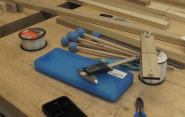At CEID, Local High School Students Learn The Music Of Engineering

Last week, students at the Center for Engineering Innovation & Design (CEID) learned about laser cutters, 3D printing, and electronic circuits – all in the name of music.
 A group of Pathways Summer Scholars – high school students in Yale’s Pathways to Science program – took part in the weeklong workshop on musical acoustics and instrument design. Pathways to Science is a coordinated STEM outreach initiative for local pre-college students. Current Yale students serve as teaching assistants and mentors on various workshops, including green chemistry, web development and coding, and neurobiology.
A group of Pathways Summer Scholars – high school students in Yale’s Pathways to Science program – took part in the weeklong workshop on musical acoustics and instrument design. Pathways to Science is a coordinated STEM outreach initiative for local pre-college students. Current Yale students serve as teaching assistants and mentors on various workshops, including green chemistry, web development and coding, and neurobiology.
The CEID hosted the music and engineering workshop, taught by SEAS senior research scientist Larry Wilen and Thibault Bertrand, a grad student in the Mechanical Engineering department. The workshop grew out of the Yale course Musical Acoustics & Instrument Design, which they co-teach with Konrad Kaczmarek, a composer and lecturer in the Department of Music.
The five-day workshop is packed with information. In addition to an extensive tour of the CEID, the students received training in making stringed instruments, designing xylophones with computer simulation, machining and using the 3D printer. One of the first things they learned was how an oscillator works. To do this, the students each act out the different parts of the oscillator, the electronic circuit that produces an audio signal. Wilen said they came up with that lesson plan for the workshop last year. When they saw how effective it was, they added it to the Musical Acoustics course.
“Some of the students don’t really get what the circuit’s doing, but when they see that, they understand it really well,” Wilen said. “These are super bright high school kids, so the stuff we do for them, we sometimes do for the Yale students also, so it’s not like we’re really toning it down for them.”
Bertrand and Wilen map out the lesson plans pretty carefully, but allow some flexibility. When they saw how interested the students were in the CEID’s laser cutter, the next day’s lesson focused on the cutter. Besides, Bertrand said, it makes sense to take advantage of the CEID’s resources.
“Working on a computer, you can do that at home or at school, but being on a laser cutter or getting their hands on a 3D printer, only at spaces likes the ones at Yale can you do that,” Bertrand said. “That was kind of the idea – when we saw them being very excited about the laser cutter, we just deviated a little to put the focus on that.”

